Bird Deaths at Solar Power Tower Revealed by FOIA Requests Made by Basin & Range Watch
Exclusive Investigative Report

October 25, 2016 - Tonopah NV - The Bureau of Land Management (BLM) agreed to release several documents and redacted sections of documents as a result of Basin and Range Watch's Freedom of Information Act lawsuit that challenged the agency's refusal to release certain documents. We are still concerned about the lack of timeliness around the responses (and the non-responses) by BLM to our Freedom of Information Act (FOIA) requests made since February 2015. In order to better understand avian-solar interactions, the fullest amount of data is needed so that scientists, agencies, and the public can agree on the best management practices to conserve our desert ecosystems and bird faunas.
Unlike the Ivanpah Solar Electric Generating System which has also caused multiple avian mortalities, and has a better record of releasing monitoring reports of bird deaths through compliance with California Energy Commission permits, the situation is very different in Nevada where the Crescent Dunes solar project and the permitting agency--Bureau of Land Management--have not been transparent about monitoring activities. Compliance reports required for mitigation on public land have been not forthcoming even after multiple FOIA requests filed by Basin & Range Watch. We filed a lawsuit earlier this year against BLM to move them to release avian monitoring reports in a timely manner.
We obtained dozens of emails, surveys, and reports concerning bird deaths at the project, although some were initially redacted in heavy black marks, supposedly to protect proprietary information and "trade secrets." Later the company who built and is operating the solar power tower, SolarReserve, agreed to release those redacted documents.
State and Federal agencies are also concerned about the lack of data-sharing by companies, as was discussed at a recent Multi-agency Avian-Solar Interactions Workshop that we attended in Sacramento CA. The best science requires transparency of raw data so that peer review can occur, as well as public review. For-profit companies should be held responsible for impacts on our irreplaceable public lands.
For background on solar flux and its unique threats posed to desert and mountain bird faunas in the Intermountain West region, see our reports for the Hidden Hills solar project and Palen solar project.

The January 2015 Incident
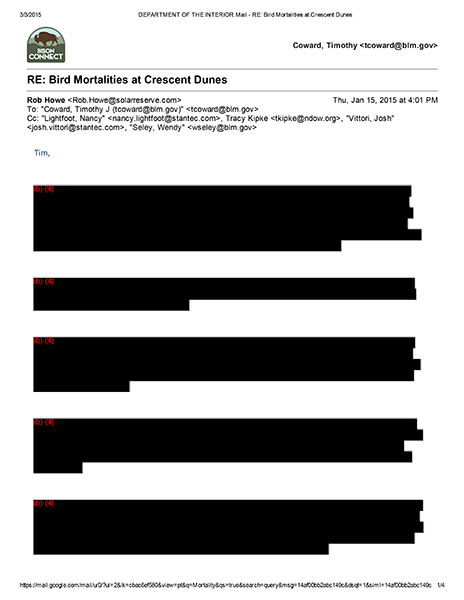
^One page that was heavily redacted from the FOIA-requested document containing emails between Stantec biologists and BLM over avian deaths observed on January 15, 2016. See the entire document >>here (pdf).
Monthly surveys are required as part of the Avian and Bat Protection Plan developed by the company as part of National Environmental Policy Act (NEPA) compliance. In January 2015, for example, Stantec wildlife biologists (the Compliance Inspection Contractor) conducted surveys along established transects within the power plant's heliostat field, around the evaporation ponds, and along the overhead transmission line, for seven consecutive days (see below). Incidental observations were also made by other contractors.
Not even in full operational mode, however, problems began to pile up. On January 14, 2015, Stantec biologists contracting with SolarReserve to monitor the project reported seeing birds pyrolize in the solar flux during testing. This was reported in an email to BLM (Tonopah office), which becomes part of the administrative record, with the subject line "Bird Mortalities at Crescent Dunes." The email reads in part:
"I left a voicemail with you at about 4:00 p.m. this afternoon regarding mortality observations at the Crescent Dunes Project today. During Tonopah Solar’s testing today there were about 1/3 of the heliostats pointed above the power tower, which formed a halo that is about 1,200 feet off the
ground. Our CIC inspector and mortality biologists observed approximately 130 birds fly into the flux halo above the power tower and become white flashes with a small smoke cloud immediately
following. These observations occurred over a four hour period. There were no carcasses that they
could find on the ground below the tower but it is clear that these are bird mortalities. Species
determinations are very difficult at the distance that the birds are flying but the mortalities appear to be song birds with some ravens and what may have even been a falcon."
The songbirds could be such resident native species as horned larks, which we have personally observed near the project on adjacent desert flats in flocks. The data sheet filled out by a biologist (see below), records horned larks, house finches, and house sparrows (introduced European cliff-dwelling birds apparently attracted to the facility infrastructure out in the desert).
Another Stantec memo dated February 12, 2015, describes the incident: "Approximately 3,000 heliostats were staged in a position which reflected light and heat to a concentrated point above the central tower. A halo above the tower was visible form the ground (Figure 1). The heat was so intense that birds flying into the halo were immediately burned and smoke was clearly evident. Approximately 115 mortalities were noted between 11:15 AM and 3:30 PM."
The surface temperature of the receiver exceeds 1,000 degrees Fahrenheit during operation. See the video of this event taken by biologists >>here. February 2015 emails obtained through FOIA show discussions by SolarReserve and BLM concerning how many "suns" (a measure of concentrated solar energy) would be a threshold for bird injury: "Discussions with the Ivanpah Solar Project’s operating staff have led us to understand that concentrations of less than 25 suns is acceptable for safe bird flight." Each mirror is equivalent to 3.5 suns. During the incident, the heliostats were arranged in a "halo" testing configuration above the receiver tower, at about 171 suns from 3,000 heliostats. During operation, this number would be much higher with the full 10,347 heliostats focused on the receiver tower.
This solar flux can be dangerous to property as well, as this excerpt from a monitoring report states: "A car bumper was melted on Sunday, February 7, 2016 by the concentrated reflection of
sunlight from the heliostats. The vehicle was in front of the control room."
^Crescent Dunes Solar Energy Project solar flux in standby position. (Photo: Jack Freer)
-2.jpg)
^Survey transects in January 2015, from FOIA-requested document (this should have been made publicly available as it is on land managed by BLM that has diverse natural communities).
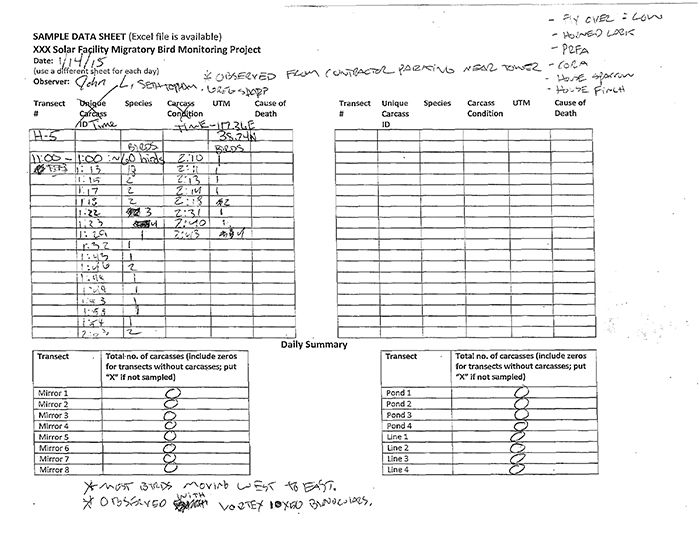
^Data sheet from the day of the large bird mortality, obtained by FOIA. Hand-written notes by the biologist record horned lark, prairie falcon, common raven, house sparrow, and house finch. No carcasses were found, giving evidence that the birds flew into the more intense solar flux and were completely pyrolized with no remains visibly found on the ground.
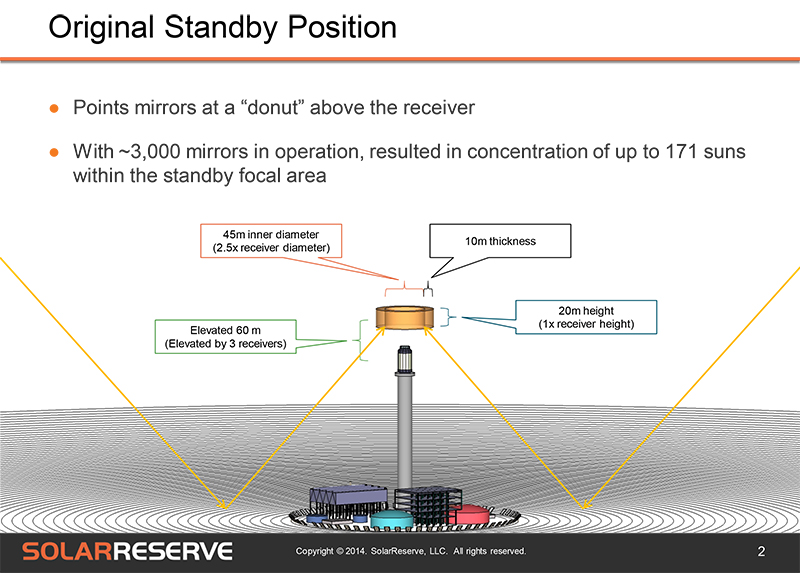
^Standby position of the solar flux during the bird mortality incident in January 2015.
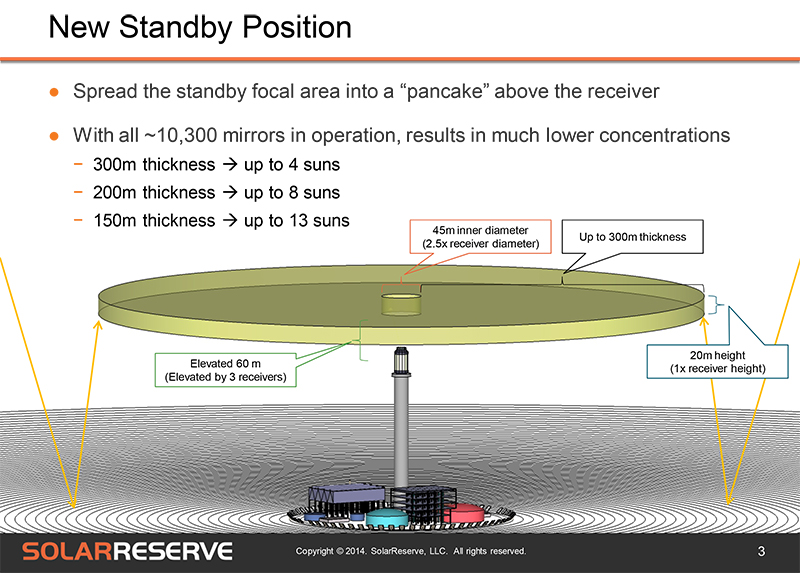
^Mitigated standby position and solar flux in "pancake" shape which has less energy, and is safer for birds. But during operation, this solar flux is focused intensely onto the receiver tower and the solar flux would become even more dangerous to birds.
Good Science and Public Transparency
Great Basin Bird Observatory (GBBO) is also doing third-party avian mortality transects on the project site, contracted by BLM. GBBO, in accordance with good science, wanted to carry out scavenging rate and detection rate studies. We would agree with carrying out such studies, which have been done at other renewable energy projects including wind projects in California. This is good science. These types of studies produce replicable results that can be compared across projects, to try to learn more about how biological monitors are able to detect birds killed and laying on the ground in a project. How many birds are missed by surveyors, and how many birds are removed by scavengers such as badgers, coyotes, ravens, and raptors? These are valid questions that need more study. This is the type of science we need in order to better understand the impacts of large-scale renewable energy projects in natural desert communities.
Solar Reserve, however, wrote BLM in a letter dated April 18, 2016, obtained legally by Basin & Range Watch through FOIA, that they were concerned with GBBO's requests to carry out good science on the project built on public lands. They wanted no such detection surveys. They also asked to change the record of the January 2015 incident to reflect their new opinion that the 100 plus bird kills in the solar flux were not birds at all, but debris or trash vaporized in the intense energy over the solar field. We do not accept this interpretation.
This Nevada Great Basin transition desert in Lower Smoky Valley is very different from the Ivanpah Valley in CA/NV with its lush east Mojave Desert habitats, so variation is expected in avian mortality surveys. Resident bird populations in the Tonopah area may be quite different and in lower density than more southerly deserts with more complex natural community structure, but migrants may also be more diverse due to the long stretches of arid basins that birds must cross to reach water sources and riparian oases (including man-made ones such as evaporation ponds). Winter may be a time of lower bird diversity in this basin than Ivanpah Valley: Stantec biologists following transects in the Crescent Dunes solar project area found no mortalities on seven consecutive days from November 20-26, 2014, and December 15-21, 2014. During this period, however, the solar power plant was still under construction with heliostats being placed and no solar flux from testing or operation. During 2016 surveys during Winter (January and February) when the plant is in operation, the bird mortality reports jump, including a Snow goose, ducks, grebes, horned larks, and a mountain bluebird. This is the kind of data that needs to be made transparent, both the agencies and to the public so that comparisons can be made, and mitigation strategies developed with the maximum amount of scientific input and interpretation.
Some email exchanges occurred where Stantec, the biological monitoring contractor hired by SolarReserve, stated that they would not take photographs of injured or dead birds on the facility, yet BLM questioned them on this, saying Nevada Division of Wildlife asked for photos to be included in monitoring reports. This shows a need to have agreed-upon, inclusive and comprehensive protocols and reporting methods across solar projects.
Bird Deaths of Diverse Species
As of April 2016 a total of 65 bird mortalities have been reported inside the facility as a result of the consolidated monitoring - 80 total mortalities including 15 mortalities in the buffer zone (outside the project fence).
Mainstream news media reporters often quote the excuse that office buildings or cats kill more birds than the Crescent Dunes solar project, but upon examining the data this is far from accurate. A diverse array of both migrants and local resident bird species have been killed at the project, both from colliding with mirrors and flying into the intense solar flux. Waterbirds mistake the mirrors for a lake, or try to land on the evaporation ponds which are used to wash wastewater from the steam turbine system out into artificial ponds. Neotropical migrants such as swallows are injured or killed. Ravens are apparently attracted to carcasses and on occasion have themselves been pyrolized in the solar flux. Raptors (hawks and eagles) that are not normally found in urban areas hunt in the area as well, perhaps attracted by waterbirds and bird carcasses.
Falcons and Hawks
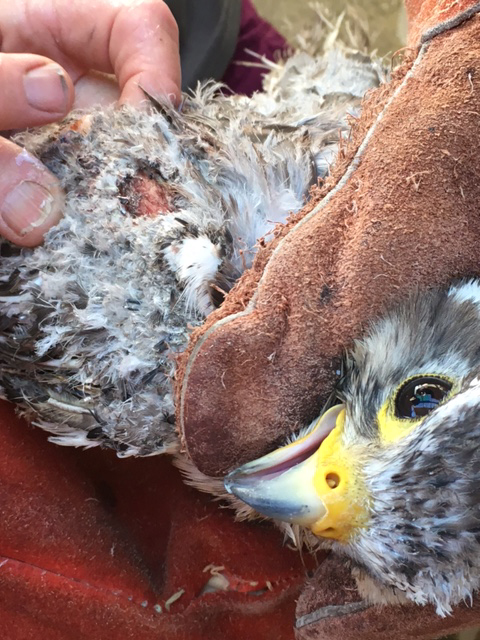
^Prairie falcon singed in solar flux.
According to emails obtained by FOIA, BLM described an incident reported by SolarReserve that a prairie falcon was seen flying into the solar flux: "On July 20, 2016 at 1730 one Falcon was reported soaring into the upper portion of the tower from the east. The bird turned white as the mirror reflected on him. He turned away and a large flume was found singed with its wing feathers curled upwards." GBBO successfully transported it to a wildlife rehabilitation facility. On July 21, 2016 an avian mortality spreadsheet listing a prairie falcon "burned", was internally circulated by BLM. The date the prairie falcon was found was July 20, 2016. On July 28, 2016, we were able to observe an injured prairie falcon that was brought to a wildlife rehabilitation facility from the Crescent Dunes solar project, singed badly by solar flux and not able to fly. On August 2, 2016 we asked BLM by email about any reports concerning this falcon incident, and some of the FOIA documents reveal that our emails were received and discussed. But we obtained no response.
Our government employees need to be responsive to the public for large projects that are built with the benefit of inexpensive public land leases, as well as generous federal tax incentives, Treasury grants, and loan guarantees.
We obtained information that a peregrine falcon was also injured in the solar flux. Perhaps it was attracted to the lake effect and evaporation pond hunting waterbirds.
On July 25, 2016 Stantec personnel found a recently fledged red-tailed hawk at the power block, no injuries could be seen but the young hawk but it could not fly well and hung out. This was from an Incident form filled out after the find, and BLM emails, obtained by FOIA by Basin & Range Watch from BLM. Questions arise as to whether the bird was blinded by solar flux, or collided with structures.
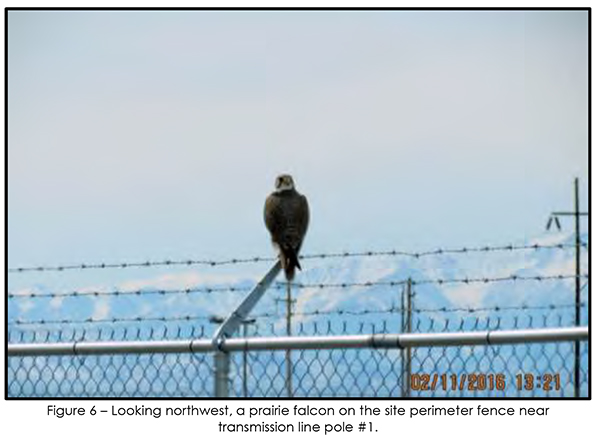
^Prairie falcon perching on the solar project perimeter fence, perhaps attracted by birds using the evaporation ponds and facility buildings constructed in a basin desert wild land. From a memo in February 2016, Stantec to BLM.
Golden eagles
One document revealed that a golden eagle flew into the flux. It was unharmed but the power tower was in more diffuse standby mode, not the full intensity of operational solar flux that drives the steam turbines to generate electricity at full capacity. It raises the question: Do eagles fly into operational flux? Do they get injured? Do they die? Do we hear about it?
One email report says:
"Avian activity within the HF during Week 239 testing consisted of common ravens, and passerines. One raven was observed flying with nesting material. On Sunday, March 27, 2016, while the heliostat field was in standby position (tower not operating), a golden eagle flew into the solar flux near the tower at the level of the receiver, and then soared above the tower and away from the project area unharmed. No avian mortalities were observed during Week 239."
As of June 2016, three golden eagle nests were found in mountains within a ten mile radius of the Crescent Dunes Solar Energy Project. Two were occupied (and young eagles observed), and one was being used by prairie falcon (see photos of two of the nests below).
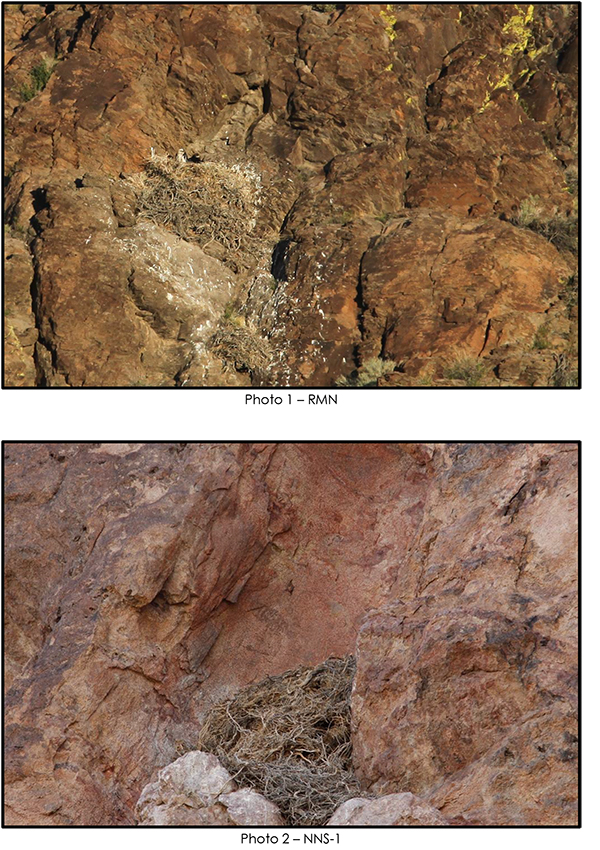
Ravens
A Stantec email dated February 11, 2015, reported two dying ravens (both died) at the evaporation ponds. We believe the ravens may have drank the evaporation ponds which are used to flush the steam turbine pipes and as evaporative cooling make-up water. The water contains dissolved solids, salts, potentially oil and grease, as well as additives to prevent algal growth in the system. These could have resulted in a toxic reaction to any bird drinking this water.
"On February 11, 2015, while conducting weekly inspections, Dave Worley (Stantec’s Construction
Inspection Contractor) noticed a common rave (Corvus corax) on the northeast side of Pond 3
that did not appear to be healthy. The raven was on a sand bank close to the water and was
observed at 8:00 a.m. Feathers were ruffled and the raven did not take flight despite Dave’s
close approach. The raven was checked again at 10:45 a.m., following a test of the heliostats.
The raven had expired by that time, and was partially submerged in the pond (Photo 1 of
Attachment 1). A Global Positioning System (GPS) coordinate was taken from the top of the
pond liner approximately 15 meters east of the bird and is included on the attached mortality
form (Attachment 2).
"Later in the day, a second raven was observed on Pond 2 that did not appear to be healthy.
The raven was sitting in the middle of the pond, south of the wetted area at 12:52 p.m. This bird
also had ruffled feathers and did not fly. Only the pond’s center was wetted, with a few inches
of water. The raven was checked again at 1:55 p.m. and was found to have expired (Photo 2).
The location of the raven was accessible and a GPS coordinate was taken at the bird’s location
(attached mortality form)."
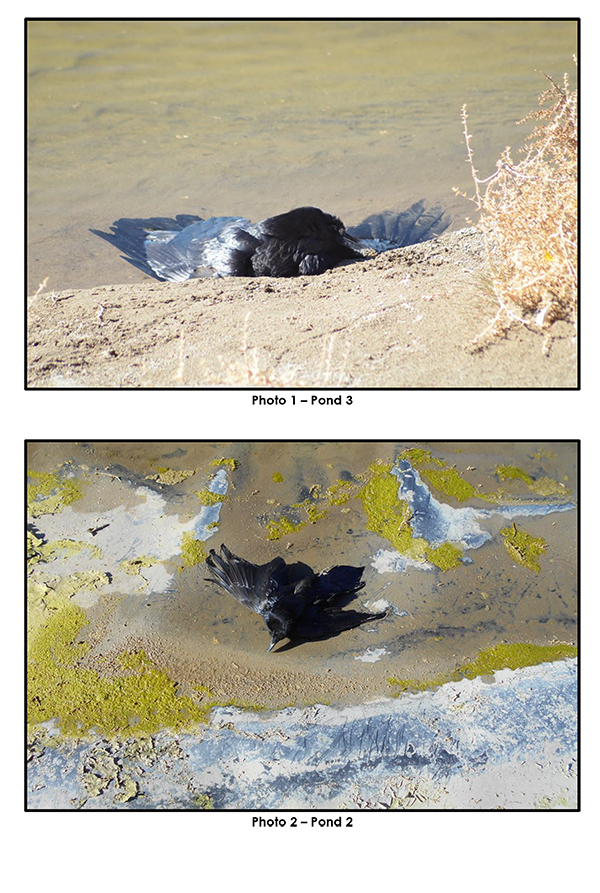
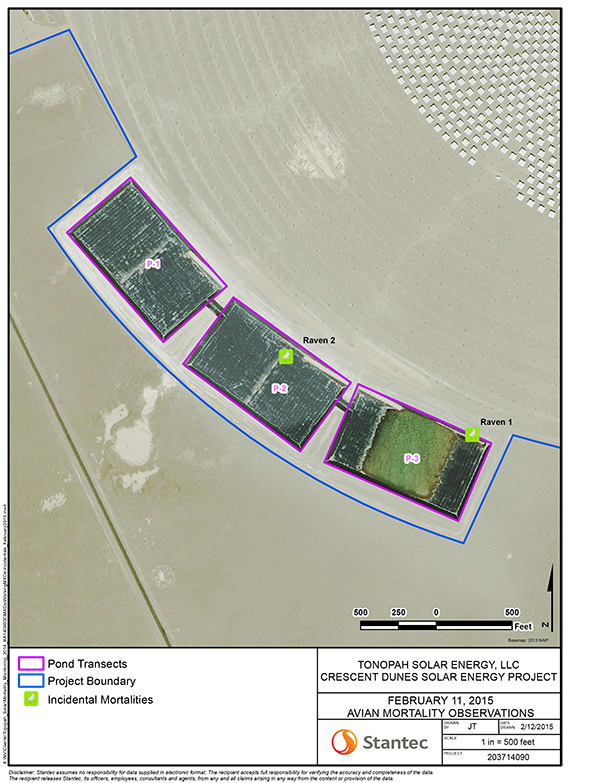
Two other ravens died as well on the solar field and evaporation ponds, and some claims of a regulated reduction of ravens at the Tonopah dump by poisoning was held up as a cause. But a BLM memo obtained by FOIA described on-site dumpsters and trash piled up next to the dumpsters attracting ravens in January 2016. The problem was dealt with at a safety meeting on January 23, 2016, but this shows how subsidized predators and scavengers being attracted to the new solar facility out in the desert miles from towns.
The memo reads in part: "First was the issue of uncovered dumpsters attracting ravens that could
potentially nest on site along with the issue of trash blowing out of the uncovered dumpsters.
Second was a concern that at several covered dumpsters (covered with orange mesh) workers
were not pulling back the mesh to throw trash in the dumpster but rather just piling trash bags near the dumpster (Figure 3) [see below].
"Prior to weeks end, Cobra had resolved both situations addressed by Stantec in the safety meeting by picking up piled trash and putting it in the dumpster and covering uncovered dumpsters with tarps (Figure 4) [see below].
"Avian species observed at the evaporation ponds, powerline corridor and heliostat field included:
common raven; savannah sparrow; house finch; green-winged teal; horned lark; song sparrow; redtailed hawk; European starling; American kestrel; eared grebe; prairie falcon; and rough-legged
hawk."
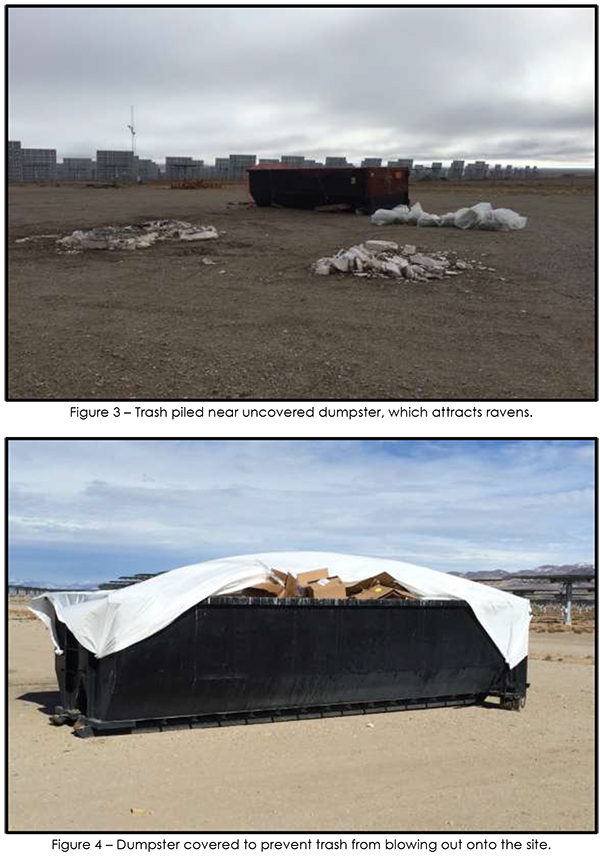 ii
ii
In March, memos from Stantec monitors to BLM addressed overfilled and un-covered dumpsters. Most dumpsters on site are now covered, stated the memo, but the dumpster on the east road remains uncovered and a source of windblown trash. The uncovered dumpsters also allow ravens to scavenge for food scraps and the CIC witnessed ravens dropping scavenged trash from the dumpster onto the ground. Even as late as April 2016, safety meetings discussed the need to pick up trash on the facility.
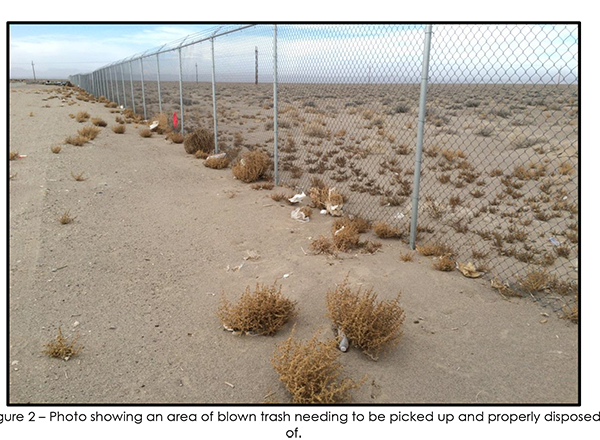
^Crescent Dunes Solar Energy Project perimeter fence. This is not a "clean, green" solar power plant on our former desert wildlands on Nevada public land. Ravens and other scavengers are attracted to this trash.
Evaporation Ponds a Bird and Wildlife Attractor?
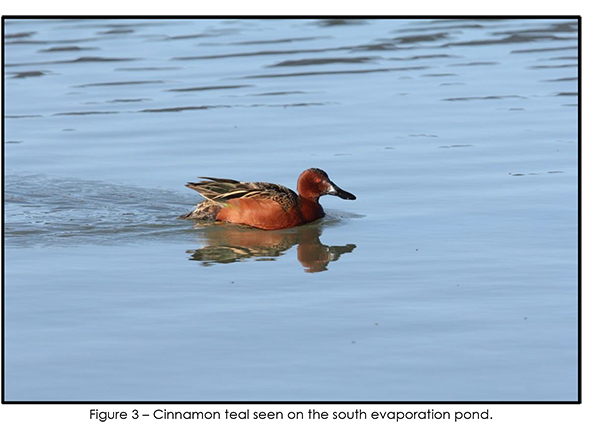
^Cinnamon teal observed on the evaporation ponds in February 2016. These artificial "lakes" in a remote desert basin are attracting a diverse array of native waterbirds. But the ponds also attract birds to the dangers of a utility-scale concentrated solar power project with super-heated solar flux and heliostat-mirror collision dangers.
An email exchange from Stantec to BLM dated February 12, 2015 shows the diversity of birds coming to the solar site:
"Birds observed at the evaporation ponds and throughout the project for Week 177 consisted of
horned lark, common raven, white-crowned sparrow, savannah sparrow, lesser goldfinch, darkeyed
junco, merlin falcon, great horned owl, prairie falcon, golden eagle, Eurasian collared-dove,
mourning dove, house finch, rock pigeon and house sparrow. During the week, temperatures were
such that the water in the evaporation ponds remained ice free. Two antelope ground-squirrels
were also observed inside the fence during Week 177."
The 30-acre evaporation ponds may be attracting birds in an area that was arid Great Basin desert before the solar project was constructed. The only other water source is the Miller's Rest Stop adjacent to US 95, a famous spot for birdwatchers. Lesser goldfinches and juncos are probably migrants through this desert, attracted to a water oasis. Eurasian collared doves, house sparrows, and rock pigeons are introduced species that are attracted to urbanized areas and may be attempting to colonize the facility to nest.
An October 1, 2014 email exchange discussed an unidentified bird wing found in the middle evaporation pond, and the head of a badger outside the project. This was during project construction.
On October 5, 2014, a dead lesser grebe was found in the evaporation ponds (see email pdf obtained by FOIA). Waterbirds were attracted to these artificial and possibly toxic man-made lakes. These industrial artificial ponds are from groundwater pumped into the project site for use in the steam cycle and other uses, and have chemical effluents that reach the pond on discharge. One email exchange on November 7, 2015 discussed the hazardous wastes that could be in this pond; chemical analysis showed it did not pose a hazard from an Environmental Protection Agency standpoint, but that a chemical effluents and pH exceeded permit levels and the water in question would be removed by tanker truck to a safe disposal site.
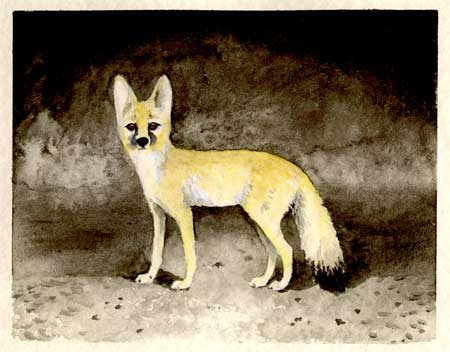
^A Kit fox was found drowned at the evaporation ponds in the solar project.
A Nevada Division of Wildlife (NDOW) Industrial Artificial Pond Permit Quarterly Wildlife Mortality Report Form, filled out for April-June 2016 by Crescent Dunes Solar Energy Facility shows more mammal, reptile, amphibian and bird deaths at the evaporation ponds or nearby regions. Mortalities associated with permitted pond solutions or structures include 6 eared grebes, 1 California gull, 1 unknown gull, 1 desert kit fox, and 1 Western whiptail lizard. Apparently the kit fox had climbed into the evaporation wastewater pond and drowned as it could not climb back out (see GBBO Monitoring Report for June 2016, below). Mortalities not associated with the ponds, but in other areas of the facility and buffer zone include 2 ravens, 1 Wilson's warbler, 1 house finch, 1 Costa's hummingbird, 2 house sparrows, 1 yellow-breasted chat, 1 rock pigeon, 2 mourning doves, 1 unknown waterfowl, 1 American badger, 1 black-tailed jackrabbit, and 1 toad. A red-necked phalarope was also found dead in the buffer area (see June 2016 GBBO Monitoring Report below).
A memo from Stantec to BLM states that netting s being installed to assist wildlife in
climbing up the slick black plastic walls that line the evaporation ponds.
In March 2016 a green-winged teal died due to being entangled in a pile of windblown Russian thistle at the bottom of the artificial evaporation pond #3 ramp, according to a memo from Stantec to BLM (see photos below).
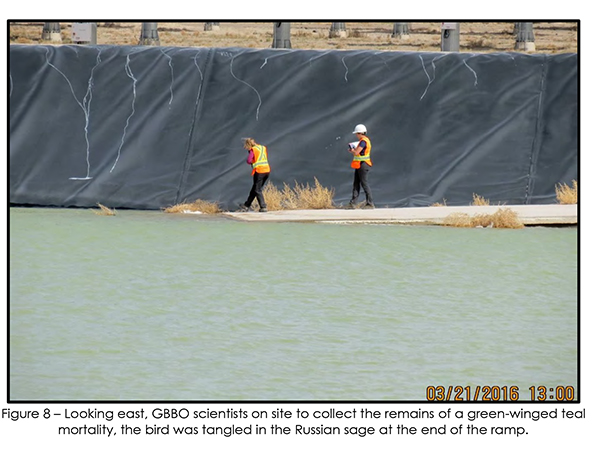
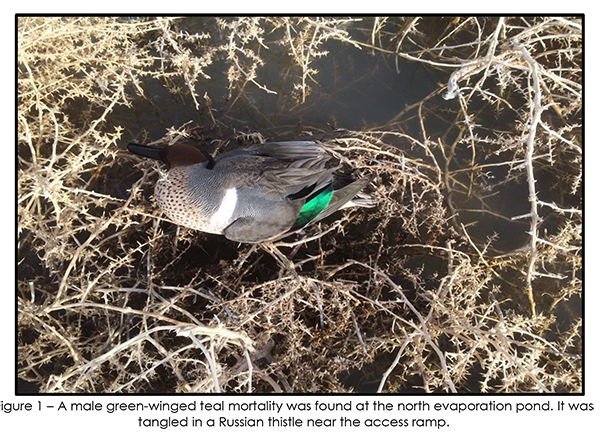
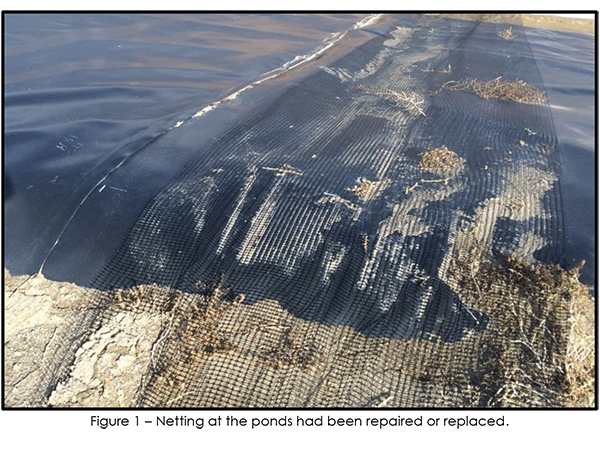
^Netting placed on the evaporation pond to help wildlife escape the slick edges when trapped.
Diverse Migrants and Resident Birds of Desert and Wetland
January, February and March of 2016
An April 21, 2016 spreadsheet recording avian mortality from January, February and March of 2016 shows a diverse sampling of the local bird life either resident in the desert, migrating through, or introduced species attracted to the buildings at Crescent Dunes Solar Energy Project. This data should be made public--we had to request it through the FOIA process which can take months. Here is a summary of the birds killed at the plant (some of these were feather spots; the list of numbers was not complete for each species):
American Avocet
Black-necked Stilt
Common Raven - 1 feather spot in January, 11 in March.
Horned Lark - 3 in January, 5 in February, 1 in March (resident desert species)
Northern Rough-winged Swallow
Cliff Swallow
Red-Shafted Flicker
Rock Pigeon (introduced)
Mourning Dove
Eurasian Collared Dove (introduced) - 1 found scavenged in February.
Townsend's Warbler
Ruby-crowned kinglet
Short-eared Owl - 1 in February, 1 in March.
Barn Owl - 1 in January
Mountain Bluebird - 1 in January (winter resident)
Dark eyed Junco
Marsh Wren
Pinyon Jay
House Finch - 1 in March
European Starling (introduced)
Western Grebe
Horned/Eared grebe - 1 in January
Green-winged Teal
Ruddy Duck - 1 in March
Snow X Ross's Goose - 1 found injured in December, died later
Nestling - 1 in March
In addition, mammals and reptiles were found dead on the projects site, causes not listed:
Long-nosed Leopard Lizard - 1 in February ("exposure")
Merriam's Kangaroo Rat
Ord's Kangaroo Rat
Chisel-toothed Kangaroo Rat
Kangaroo Rat - 4
Dark kangaroo mouse
unknown mouse
Grasshopper mouse
Pocket Gopher
Black-tailed jackrabbit
A BLM memo obtained by FOIA described a songbird mortality in "super-heated flux" during the week of January 19-24, 2016, during testing: "One avian mortality was observed during Week 230. At 1:35 PM the biologist observing the test, watching for avian mortality, noted a passerine fly into the super-heated flux. The bird flew into the flux and began to smoke at which point it changed course in an attempt to exit the flux but was unable to do so. The mortality was noted on the west side of the tower and a carcass, if anything remained, was thought to have fallen into the power block on the west side. Two other Stantec biologists were on site at the time of the mortality and searched for the carcass with no success. The Stantec biologists were accompanied by Solar Reserve to vantage points within the Power Block where binoculars were utilized to look on the roof and tops of the tanks for a possible carcass."
Not all observed birds were harmed by solar flux, some flew past the solar project unharmed, as noted in a memo for March 2016 from Stantec to BLM: "During system test monitoring, 10 to 20 California gulls flew up around the tower, but all flew away unharmed. A small accipiter flew near the tower and also flew away unharmed." We need more objective observations like this to fully understand these solar projects constructed in remote desert wildlands with the best possible science and public accountability.
April 2016
GBBO carried out avian use and mortality surveys, for which we have several monthly reports for 2016. They describe their methods as: "Survey cycles were completed in two-week intervals, as specified for the spring migration season in our work agreement. The scope of a complete survey cycle consists of eighty plot-based mortality surveys in the facility and in the surrounding 2-mile buffer zone, as well as surveys along the entire facility fence line and around the three waste water ponds. Avian use surveys include sixty randomly distributed point count points within the buffer zone and the facility, four regional ten-point transects, and an inventory of individuals using the ponds once during the cycle. Two survey cycles were completed in April 2016." Mortalities for April 2016 include (see GBBO April 2016 Monitoring Narrative):
Horned Lark - Buffer - Incidental find outside of surveys. Part of a wing
Eared Grebe - North Pond, early decomposition (see photo below)
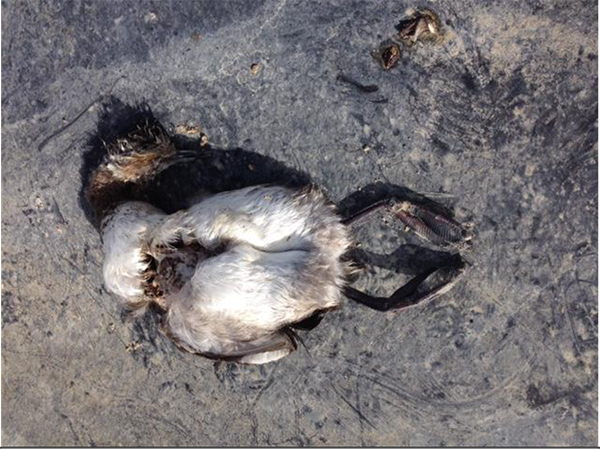
Unknown Waterfowl - Facility, part of a wing
European Starling - Fence Line, feather spot
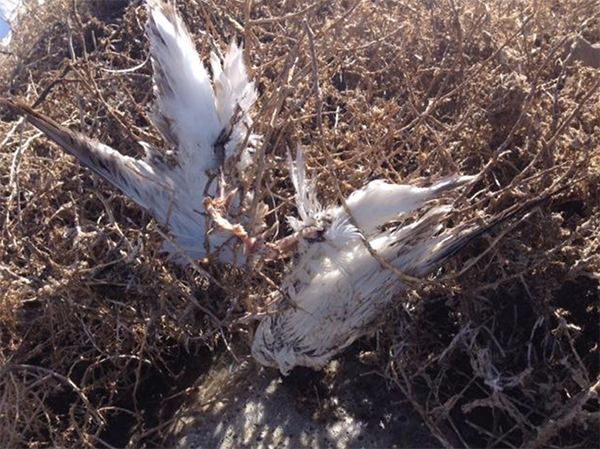
Ring-billed Gull - Middle evaporation pond, predation; head and body cavity missing (see photo above)
Common Raven - Incidental find by facility worker. Wing injury with open wound, wing broken, bird soon died. Possibly due to a collision with the facility.
A house finch was also found dead incidental to surveys.
Mammals found dead included black-tailed jackrabbit, Ord's kangaroo rat, desert kangaroo rat, Merriam's kangaroo rat, deer mouse and Great Basin pocket mouse.
Other surveys counted birds living in or visiting the facility, and a large diversity of birds were found. Most common were brown-headed cowbirds and ravens, both species attracted to artificial structures and human disturbance. Outside the facility in the desert natural communities, horned larks and black-throated sparrows were most common. The evaporation ponds were attracting waterbirds like a natural lake or wetland, and common birds included eared grebes, ruddy ducks, ring-billed gulls and California gulls. But a great diversity of other waterbirds were counted, including diverse ducks, double-crested cormorant, sandpipers, and white-faced ibis. These artificial ponds may be attracting waterbirds on flyways between Mono Lake, Walker Lake, Great Salt Lake, Pahranagat wetland system, and the Amargosa River/Ash Meadows wetland systems. This needs more study. Predated waterbirds perhaps are due to prairie falcons and peregrine falcons in part, both species having been recorded and injured at this power plant, probably attracted to the prey base forming at this location.
May 2016
The GBBO Monitoring Report for May 2016 contains these mortalities:
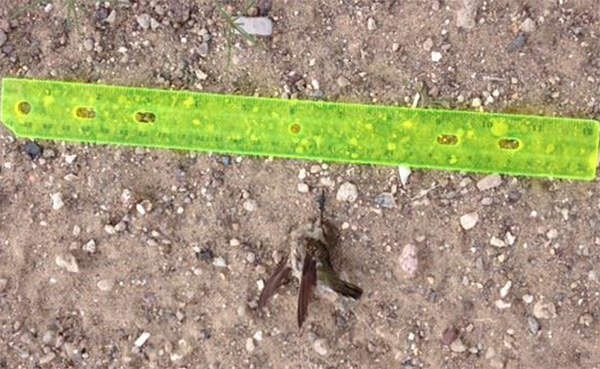
Costa's hummingbird - Facility, intact (see photo above)
Eurasian collared-doves (2)- Fence line feather spot
Mourning Dove - Fence line, feather spot
A few unknown passerine (small songbird) body parts were also found.
Additional mortalities were found that month as well, GBBO reports: "There were five mortalities discovered by Stantec or facility workers that were collected by GBBO under our USFWS and NDOW special use permits. These mortalities included two Eared Grebes, a Eurasian Collared-Dove, a Yellow-breasted Chat, and a Rock Pigeon. Two birds were also reported injured by facility workers and showed signs of heat or flux injuries, including a Tree Swallow and a Lewis’s Woodpecker. Both were brought to wildlife rehabilitation facilities by GBBO. The Tree Swallow died a few days later, likely due to stress caused by its injuries, and the Lewis’s Woodpecker was euthanized when it was determined it’s injuries were too severe for rehabilitation."
A memo detailed the Lewis's woodpecker injury: "Stantec biologists also reported an incident involving a Lewis’s woodpecker (Melanerpes lewisi) on May 12, 2016. The bird was located alive; in the shade under a hot salt tank approximately 45 feet from heliostat transect 1. Both wings and tail feathers were singed, and the bird had a strong burnt odor; similar to the smell of burnt hair. The bird was very active and appeared to be in good health, aside from singed feathers. Great Basin Bird Observatory collected the bird on May 12, 2016 and transferred to a rehabilitation specialist."
Mammalian mortalities included two Northern grasshopper mice, an Ord’s kangaroo rat, and a Merriam’s kangaroo rat.
June 2016
The GBBO Monitoring Report for June 2016 contains the following mortality data and observations:
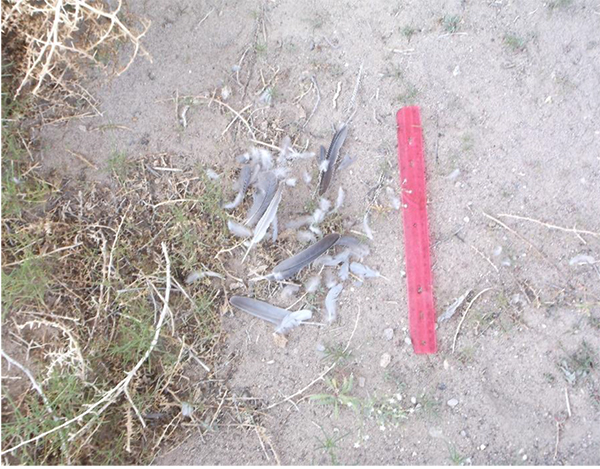
^One of the feather spot of a bird mortality, indicating probable predation and/or scavenging.
Unknown bird - Fence line Feather spot
Red-necked Phalarope - Fence line, wing only
Unknown dove - Facility feather spot
Unknown dove - Facility feather spot
California Gull - Ponds. No identifiable cause of death. Feathers worn, but did not appear singed. A sickly gull was observed a few days before. (See photo below)
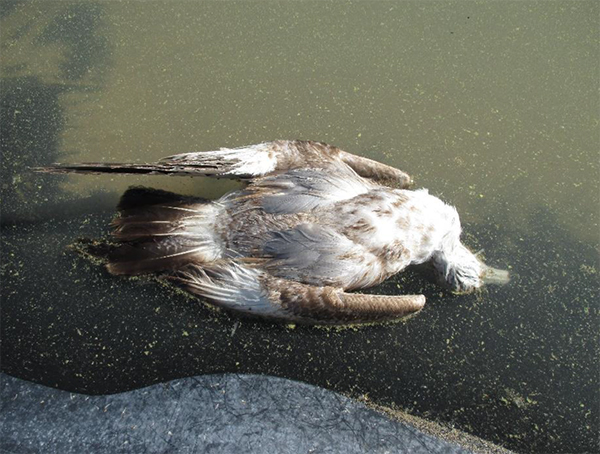
Eared Grebe - Ponds. Head missing, from predation.
Green-winged Teal - Facility. Wing only
Eared Grebe - Ponds
Scavenged Horned Lark - Buffer Feather spot- tail feathers
The report states: "There were ten non-avian mortalities discovered in the facility and buffer zone by GBBO surveyors. All mortalities found the facility heliostat field had been scavenged/predated and included the remains of a black-tailed jackrabbit, a chisel-toothed kangaroo rat, an Ord’s kangaroo rat, and an unidentifiable rodent. During mortality surveys at the evaporation ponds, a kit fox, a whiptail lizard (see photo below), and a desert wood rat were found in and around the ponds. It is likely they had climbed into the ponds, couldn’t climb out, and drowned. The whiptail and wood rat were intact and showed no signs of trauma, but the kit fox was partially decomposed."
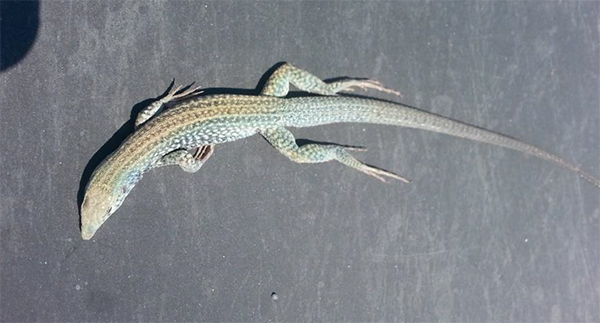
^Western whiptail lizard drowned in the evaporation ponds.
House finches, horned larks, house sparrows, and ravens were the most common birds observed alive in the facility. Horned larks, black-throated sparrows, and sagebrush sparrows were common in the buffer zone surrounding desert. At the evaporation ponds eared grebes were most abundant. There was a high number of Wilson’s Phalaropes recorded due to a single observation on June 27th of 72 individuals.
A summary avian mortality list obtained by FOIA by Basin & Range Watch from BLM shows 36 total bird mortalities for June and July 2016. 42% of birds were burned (in the solar flux), mostly swallows and the prairie falcon (found burned July 20, 2016). 14 swallows were burned, most unknown but also 2 cliff swallows, a tree swallow. A bank swallow was found dead but not burned.
A memo from February 2016 notes the Stantec biologist observing puffs of smoke from apparent insects (butterflies and beetles perhaps), and debris blowing in breezes, into the solar flux. But this is very different than other observations of birds witnessed flying into the solar flux and burning. Trash and debris are not the only cause of smoke puffs visible in the solar flux.
July 2016
Through spring and early summer, the solar power tower apparently had testing problems and was not operational for long stretches of times as problems were worked out. By July, the plant may have gone into full operational mode for longer periods, and this is when solar flux mortalities start appearing in greater numbers. Through the FOIA process we obtained a memo from Stantec to BLM dated July 18, 2016 about swallows singed and killed while flying through the solar flux: "Three mortalities were observed or located by Stantec biologists during the July 2016 surveys. One cliff swallow (Petrochelidon pyrrhonota), one tree swallow (Tachycineta bicolor), and one unknown avian species mortality were reported by Stantec biologists on July 9, 2016. The cliff swallow was found near the cooling fans in the power block. The tree swallow was found near the salt storage tank in the power block. Both of these mortalities were recorded with burned/singed feathers on the carcasses. The unknown species may have been a swallow and was observed flying in to the zone of heated solar flux near the tower (note the location on the attached figure is the location of the observing biologist, not the location of the mortality). The location where the bird appeared to have fallen was searched, but no carcass was found." No photographs were included.
The prairie falcon described above was injured in the solar flux (see our photo below), as well as a Lewis's woodpecker. We are trying to obtain these reports through FOIA.
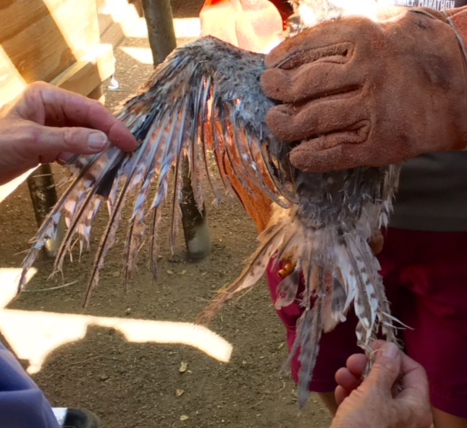
^The prairie falcon with singed wings and tail, at a wildlife rehabilitation center (our own photo).
Conclusion
These bird deaths and injuries are different from cat predation and urban collisions. These are birds that breed in Sky Island montane habitats and desert basins, Neotropical migrants that need specialized undisturbed natural communities such as wetlands, riparian oases, ephemeral playa lakes, and springs for resting. Waterbirds such as ducks and grebes, and raptors such as golden eagles and prairie falcons use these remote desert wetland and upland habitats. These are not birds that are typically found in urban areas. Check out eBird for the amazing diversity of bird species found at the nearby Miller's Rest Stop, this gives a sample of the many migrants seeking out desert wetlands and springs--including artificial water sources. There are many rare birds found moving through this remote desert, and avian winter and summer residents using these arid habitats.
Why develop massive industrial energy projects in remote wildlands on public land with diverse natural communities and bird life, hundreds of miles distant from urban load centers, when better alternatives are available? Basin & Range Watch supports advanced Distributed Energy Resources such as rooftop solar and local battery storage, energy efficiency, load-shifting technologies, microgrids, and other more sustainable form of renewable energy in the built environment.
HOME...Updates...Solar Flux...Injured Prairie Falcon...Basin & Range Watch Complaint Against BLM
